-
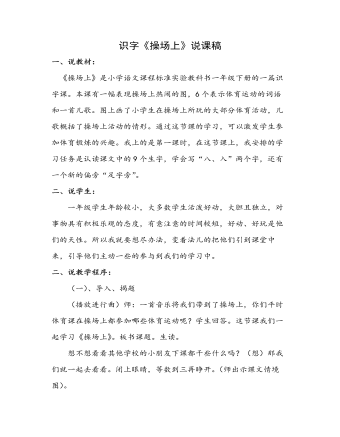
部编人教版一年级下册识字《操场上》说课稿
(二)、学习字词1、看图说话,认识体育活动的名称。师:看,操场上多热闹啊!这些小朋友都在干什么呢?(生:有的在跑步、有的在打球.......)师:你们说的真棒!老师告诉你们一个秘密,刚才你们说的体育活动中就藏着我们今天要学习的词语宝宝,咱们一起把他们读出来怎样?(师点击课件出示词语)2、这些词语你们认识吗?(如有认识的就请他读一读)不认识怎么办呢?利用拼音自已读一读,指名读、集体读。3、教师:去掉拼音小朋友们还认得这些字吗?我们来比一比看哪一组的小朋友反应最快了。利用课件,检查学生认读情况。4、组织学生看老师手里的卡片不出声做动作。5、小朋友看刚才我们学的词语中有的是用手做的动作,有的是用脚做的动作,那么请几个小朋友互相合作找一找哪些是用手做的动作,哪些是用脚做的动作?师生一起总结学习:“扌、足”。将字分类写在黑板上。
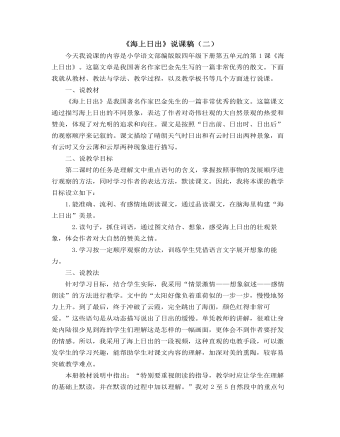
部编人教版四年级下册《海上日出》说课稿(二)
今天我说课的内容是小学语文部编版版四年级下册第五单元的第1课《海上日出》。这篇文章是我国著名作家巴金先生写的一篇非常优秀的散文。下面我就从教材、教法与学法、教学过程,以及教学板书等几个方面进行说课。一、说教材《海上日出》是我国著名作家巴金先生的一篇非常优秀的散文。这篇课文通过描写海上日出的不同景象,表达了作者对奇伟壮观的大自然景观的热爱和赞美,体现了对光明的追求和向往。课文是按照“日出前、日出时、日出后”的观察顺序来记叙的。课文描绘了晴朗天气时日出和有云时日出两种景象,而有云时又分云薄和云厚两种现象进行描写。二、说教学目标第二课时的任务是理解文中重点语句的含义,掌握按照事物的发展顺序进行观察的方法,同时学习作者的表达方法,默读课文。因此,我将本课的教学目标设立如下:
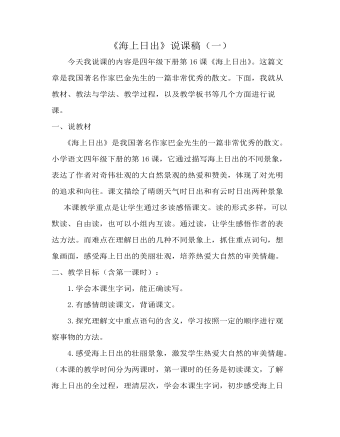
部编人教版四年级下册《海上日出》说课稿(一)
一、说教材《海上日出》是我国著名作家巴金先生的一篇非常优秀的散文。小学语文四年级下册的第16课,它通过描写海上日出的不同景象,表达了作者对奇伟壮观的大自然景观的热爱和赞美,体现了对光明的追求和向往。课文描绘了晴朗天气时日出和有云时日出两种景象本课教学重点是让学生通过多读感悟课文。读的形式多样,可以默读、自由读,也可以小组内互读。通过读,让学生感悟作者的表达方法。而难点在理解日出的几种不同景象上,抓住重点词句,想象画面,感受海上日出的美丽壮观,培养热爱大自然的审美情趣。二、教学目标(含第一课时):1.学会本课生字词,能正确读写。2.有感情朗读课文,背诵课文。3.探究理解文中重点语句的含义,学习按照一定的顺序进行观察事物的方法。
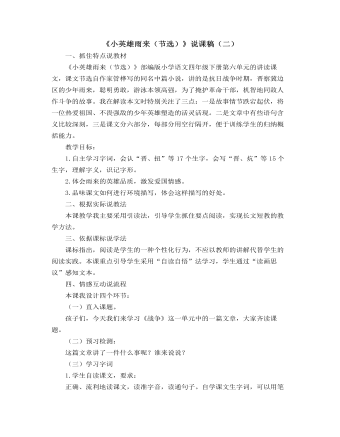
部编人教版四年级下册《小英雄雨来》说课稿(二)
一、抓住特点说教材《小英雄雨来(节选)》部编版小学语文四年级下册第六单元的讲读课文,课文节选自作家管桦写的同名中篇小说,讲的是抗日战争时期,晋察冀边区的少年雨来,聪明勇敢,游泳本领高强,为了掩护革命干部,机智地同敌人作斗争的故事。我在解读本文时特别关注了三点:一是故事情节跌宕起伏,将一位热爱祖国、不畏强敌的少年英雄塑造的活灵活现。二是文章中有些语句含义比较深刻,三是课文分六部分,每部分用空行隔开,便于训练学生的归纳概括能力。教学目标:1.自主学习字词,会认“晋、扭”等17个生字,会写“晋、炕”等15个生字,理解字义,识记字形。2.体会雨来的英雄品质,激发爱国情感。3.品味课文如何进行环境描写,体会这样描写的好处。
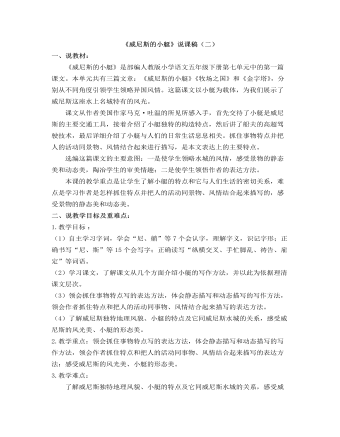
部编人教版五年级下册《威尼斯的小艇》说课稿(二)
四、说教法和学法:1.说教法:在教学过程中激发学生的学习兴趣,为学生创设良好的自主学习情境,充分发挥学生的主动性和积极性,注重培养学生自主学习的意识和习惯,尊重学生的个体差异,倡导自主、合作、探究的学习方式,充分发挥小组教学的优势,充分发挥教师的潜能。所以我采用了“阅读——思考——交流——评议”的教学模式,所谓“阅读——思考”就是独立学习,在教师指导下进行自读自悟;“交流”就是鼓励学生质疑问难,通过读课文提出问题,并尽可能自己解决疑问,让学生通过自身的实践——动脑、动口、动手,获得新知;“评议”就是对别人发言进行评价,也可以提出不同的见解。最终达到培养学生具有感受、理解、欣赏和评价能力的目标。
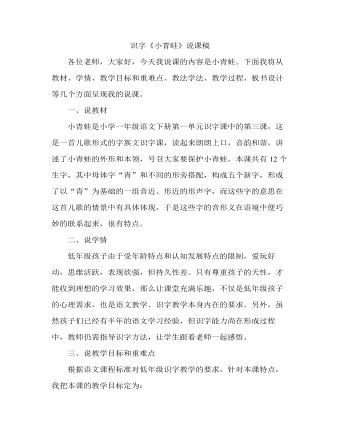
部编人教版一年级下册识字 《小青蛙》说课稿
一、说教材小青蛙是小学一年级语文下册第一单元识字课中的第三课,这是一首儿歌形式的字族文识字课,读起来朗朗上口,音韵和谐,讲述了小青蛙的外形和本领,号召大家要保护小青蛙。本课共有12个生字,其中母体字“青”和不同的形旁搭配,构成五个新字,形成了以“青”为基础的一组音近、形近的形声字,而这些字的意思在这首儿歌的情景中有具体体现,于是这些字的音形义在语境中便巧妙的联系起来,很有特点。二、说学情低年级孩子由于受年龄特点和认知发展特点的限制,爱玩好动,思维活跃,表现欲强,但持久性差。只有尊重孩子的天性,才能收到理想的学习效果,那么让课堂充满乐趣,不仅是低年级孩子的心理需求,也是语文教学、识字教学本身内在的要求。另外,虽然孩子们已经有半年的语文学习经验,但识字能力尚在形成过程中,教师仍需指导识字方法,让学生跟着老师一起感悟。
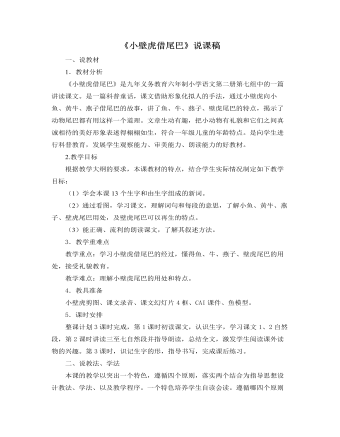
部编人教版一年级下册《小壁虎借尾巴》说课稿
2.教学目标根据教学大纲的要求,本课教材的特点,结合学生实际情况制定如下教学目标:(1)学会本课13个生字和由生字组成的新词。(2)通过看图,学习课文,理解词句和每段的意思,了解小鱼、黄牛、燕子、壁虎尾巴用处,及壁虎尾巴可以再生的特点。(3)能正确、流利的朗读课文,了解其叙述方法。3.教学重难点教学重点:学习小壁虎借尾巴的经过,懂得鱼、牛、燕子、壁虎尾巴的用处,接受礼貌教育。教学难点:理解小壁虎尾巴的用处和特点。4.教具准备小壁虎剪图、课文录音、课文幻灯片4框、CAI课件、鱼模型。5.课时安排整课计划3课时完成,第1课时初读课文,认识生字,学习课文1、2自然段,第2课时讲读三至七自然段并指导朗读,总结全文,激发学生阅读课外读物的兴趣。第3课时,识记生字的形,指导书写,完成课后练习。
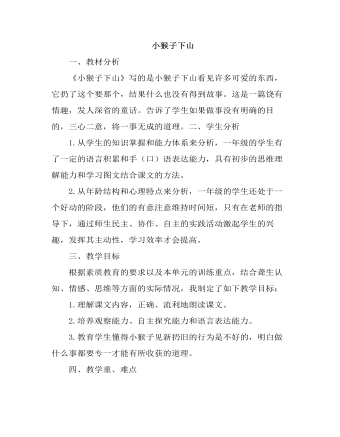
部编人教版一年级下册《小猴子下山》(说课稿)
三、教学目标根据素质教育的要求以及本单元的训练重点,结合聋生认知、情感、思维等方面的实际情况,我制定了如下教学目标:1.理解课文内容,正确、流利地朗读课文。2.培养观察能力、自主探究能力和语言表达能力。3.教育学生懂得小猴子见新扔旧的行为是不好的,明白做什么事都要专一才能有所收获的道理。四、教学重、难点本课的关键是必须处理好形象的图和抽象的文字之间的关系,因为只有图文紧密结合了,才能使学生了解小猴子活动的顺序和事物之间的联系,从而有效的发展学生的语言和思维。五、说教法、学法1.教法结合学生的个体差异和不同的学习需求,依据本课故事性强,画面丰富,结构类似的特点,我主要采取了以下教学方法:(1)图文结合的情景教学法。(2)以扶为主的扶放教学法。(3)读思结合的品读感悟法。
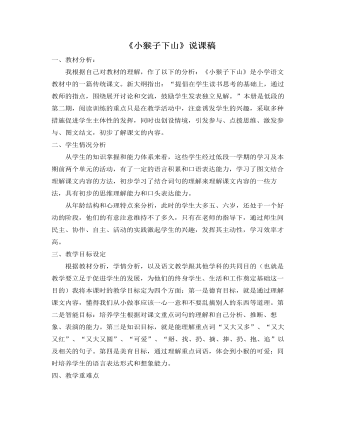
部编人教版一年级下册《小猴子下山》说课稿
二、学生情况分析从学生的知识掌握和能力体系来看,这些学生经过低段一学期的学习及本期前两个单元的活动,有了一定的语言积累和口语表达能力,学习了图文结合理解课文内容的方法,初步学习了结合词句的理解来理解课文内容的一些方法,具有初步的思维理解能力和口头表达能力。从年龄结构和心理特点来分析,此时的学生大多五、六岁,还处于一个好动的阶段,他们的有意注意维持不了多久,只有在老师的指导下,通过师生间民主、协作、自主、活动的实践激起学生的兴趣,发挥其主动性,学习效率才高。三、教学目标设定根据教材分析,学情分析,以及语文教学跟其他学科的共同目的(也就是教学要立足于促进学生的发展,为他们的终身学生、生活和工作奠定基础这一目的)我将本课时的教学目标定为四个方面:第一是德育目标,就是通过理解课文内容,懂得我们从小做事应该一心一意和不要乱摘别人的东西等道理。第二是智能目标:培养学生根据对课文重点词句的理解和自己分析、推断、想象、表演的能力。第三是知识目标,就是能理解重点词“又大又多”、“又大又红”、“又大又圆”、“可爱”、“掰、找、扔、摘、捧、扔、抱、追”以及相关的句子。第四是美育目标,通过理解重点词语,体会到小猴的可爱;同时培养学生的语言表达形式和想象能力。
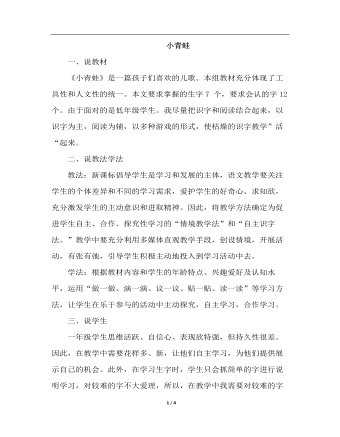
部编人教版一年级下册识字《小青蛙》(说课稿)
一、说教材《小青蛙》是一篇孩子们喜欢的儿歌。本组教材充分体现了工具性和人文性的统一。本文要求掌握的生字7 个,要求会认的字12个。由于面对的是低年级学生。我尽量把识字和阅读结合起来,以识字为主,阅读为辅,以多种游戏的形式,使枯燥的识字教学”活“起来。二、说教法学法教法:新课标倡导学生是学习和发展的主体,语文教学要关注学生的个体差异和不同的学习需求,爱护学生的好奇心、求知欲,充分激发学生的主动意识和进取精神。因此,将教学方法确定为促进学生自主、合作、探究性学习的“情境教学法”和“自主识字法。”教学中要充分利用多媒体直观教学手段,创设情境,开展活动,有张有弛,引导学生积极主动地投入到学习活动中去。
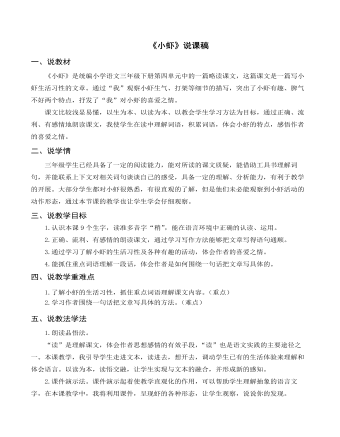
(说课稿)部编人教版三年级下册《小虾》
一、说教材《小虾》是统编小学语文三年级下册第四单元中的一篇略读课文,这篇课文是一篇写小虾生活习性的文章。通过“我”观察小虾生气、打架等细节的描写,突出了小虾有趣、脾气不好两个特点,抒发了“我”对小虾的喜爱之情。 课文比较浅显易懂,以生为本、以读为本、以教会学生学习方法为目标,通过正确、流利、有感情地朗读课文,我使学生在读中理解词语,积累词语,体会小虾的特点,感悟作者的喜爱之情。二、说学情三年级学生已经具备了一定的阅读能力,能对所读的课文质疑,能借助工具书理解词句,并能联系上下文对相关词句谈谈自己的感受,具备一定的理解、分析能力,有利于教学的开展。大部分学生都对小虾很熟悉,有很直观的了解,但是他们未必能观察到小虾活动的动作形态,通过本节课的教学也让学生学会仔细观察。
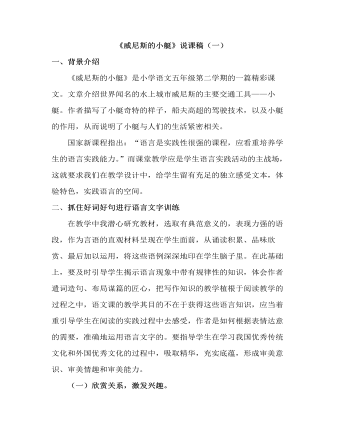
部编人教版五年级下册《威尼斯的小艇》说课稿(一)
一、背景介绍 《威尼斯的小艇》是小学语文五年级第二学期的一篇精彩课文。文章介绍世界闻名的水上城市威尼斯的主要交通工具——小艇。作者描写了小艇奇特的样子,船夫高超的驾驶技术,以及小艇的作用,从而说明了小艇与人们的生活紧密相关。国家新课程指出:“语言是实践性很强的课程,应看重培养学生的语言实践能力。”而课堂教学应是学生语言实践活动的主战场,这就要求我们在教学设计中,给学生留有充足的独立感受文本,体验特色,实践语言的空间。二、抓住好词好句进行语言文字训练在教学中我潜心研究教材,选取有典范意义的,表现力强的语段,作为言语的直观材料呈现在学生面前,从诵读积累、品味欣赏、最后加以运用,将这些语例深深地印在学生脑子里。
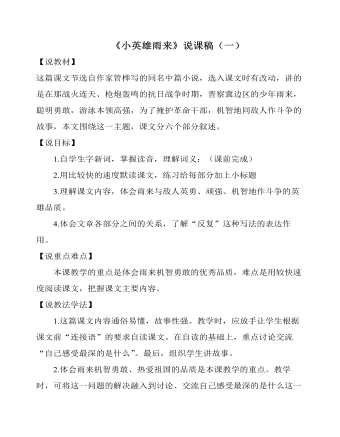
部编人教版四年级下册《小英雄雨来》说课稿(一)
【说教材】这篇课文节选自作家管桦写的同名中篇小说,选入课文时有改动,讲的是在那战火连天、枪炮轰鸣的抗日战争时期,晋察冀边区的少年雨来,聪明勇敢,游泳本领高强,为了掩护革命干部,机智地同敌人作斗争的故事,本文围绕这一主题,课文分六个部分叙述。【说目标】1.自学生字新词,掌握读音,理解词义;(课前完成)2.用比较快的速度默读课文,练习给每部分加上小标题3.理解课文内容,体会雨来与敌人英勇、顽强、机智地作斗争的英雄品质。

人教版高中英语必修4Body Language说课稿4篇
Textbook: Senior English for China (Book 4), by Liu Daoyi Time Allotment: 1 period (40 minutes)Date: March 20, 2014Teaching aids: blackboard, Multi-media, Power Point, chalk I. Text Analysis (教材分析)This unit is about body language, and the text selected in the reading part demonstrates the difference and similarity of body language in many parts of the world. Through learning this passage, students are required to raise their awareness of using body language in different parts of the world. As body language is closely related to our daily life, it is easy to arouse students’ interest in learning this text. Reading skills and speaking training are designed around the text.II. Teaching Objectives (教学目标)By the end of the lesson, students will be able to:1. Language Skill Objective(语言技能目标): develop reading ability (skimming and scanning)as well as speaking ability.2. Cultural Knowledge Objective(文化知识目标): know about the cultural differences of using body language.3. Affective Objective(情感目标): increase students’ awareness of using body language correctly in different cultures. III.Teaching Focuses and Difficulties(教学重点和难点)1. Teaching Focuses(教学重点): the difference and similarity of body language in many parts of the world.2. Teaching Difficulties(教学难点): develop students’ reading abilities of skimming and scanning and ask the students to show their opinions with fluent English.

人教版高中英语必修4Women of achievement说课稿4篇
Good morning, distinguished judges:It’s my honor to talk about my teaching ideas with you. Today my topic is Women of Achievement. My presentation consists of six parts: the analysis of teaching material and student, teaching aims, key and difficult points, teaching and studying method, teaching procedures and blackboard design.First, let’s focus on the analysis of teaching material. This lesson is from New Senior English for China Student’s Book 4 Unit 1, the reading part. The main topic of the passage is the introduction of a student of Africanwildlife. After this lesson, the students will learn more information about her studying chimps in Africa, and their reading and speaking abilities can be developed as well.The next part is the analysis of students. My students are in senior high students. They have learnt English for many years, they’ve known many words and sentences, but their speaking and reading abilities are still not very good. So I will practice their speaking and reading abilities through different exercises.According to the New Standard Curriculum and the present situation, I set the teaching aims as follows: firstly, knowledge aims. Students can grasp some new words, such as worthwhile, move off. Moreover, students can understand the content of the passage and get familiar with the topic of studying chimps in wildlife. Secondly, ability aims. Students can use reading strategies such as skimming and scanning in reading process. Thirdly, emotional aims. Students can have the awareness of protecting animals and care about animals.Based on the above analysis, the key point of this lesson is to get the main idea and the detailed information from the passage; the difficult point is to talk about the wildlife protection and use reading strategies.
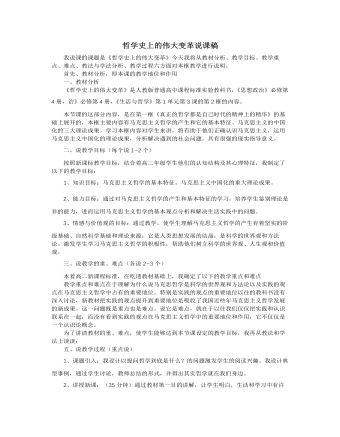
人教版高中政治必修4哲学史上的伟大变革说课稿(一)
2、讲授新课:(35分钟)通过教材第一目的讲解,让学生明白,生活和学习中有许多蕴涵哲学道理的故事,表明哲学并不神秘总结并过渡:生活也离不开哲学,哲学可以是我正确看待自然、人生、和社会的发展,从而指导人们正确的认识和改造世界。整个过程将伴随着多媒体影像资料和生生对话讨论以提高学生的积极性。3、课堂反馈,知识迁移。最后对本科课进行小结,巩固重点难点,将本课的哲学知识迁移到与生活相关的例子,实现对知识的升华以及学生的再次创新;可使学生更深刻地理解重点和难点,为下一框学习做好准备。4、板书设计我采用直观板书的方法,对本课的知识网络在多媒体上进行展示。尽可能的简洁,清晰。使学生对知识框架一目了然,帮助学生构建本课的知识结构。5、布置作业我会留适当的自测题及教学案例让同学们做课后练习和思考,检验学生对本课重点的掌握以及对难点的理解。并及时反馈。对学生在理解中仍有困难的知识点,我会在以后的教学中予以疏导。
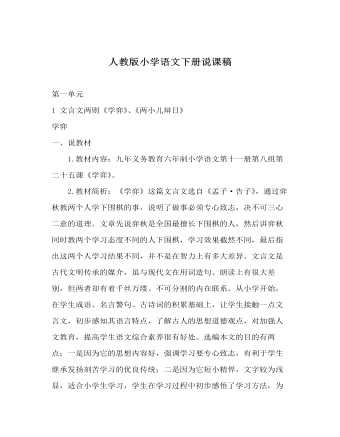
人教版《学弈》《两小儿辩日》说课稿
2.教材简析:《学弈》这篇文言文选自《孟子·告子》,通过弈秋教两个人学下围棋的事,说明了做事必须专心致志,决不可三心二意的道理。文章先说弈秋是全国最擅长下围棋的人,然后讲弈秋同时教两个学习态度不同的人下围棋,学习效果截然不同,最后指出这两个人学习结果不同,并不是在智力上有多大差异。文言文是古代文明传承的媒介,虽与现代文在用词造句、朗读上有很大差别,但两者却有着千丝万缕、不可分割的内在联系。

人教版高中英语必修4A taste of English Humor说课稿3篇
Then I would ask them to think of a funny English or Chinese and tell it to partners. While telling stories, they can use expressions and some acting to help make the story funny. 5 minutes would be given to do this.Those stories they told there will be the material for their writing. Soletting them tell it at first is helpful. And they can make a difference between telling a funny story and writing it down. Generally speaking, it is difficult forstudents to write well because they don’t know what to write and how to write. Asking them to tell their own stories at first can help them come up with what to write.After their telling, I would invite someone to share his/her story with all of us and I would write it down on the blackboard.This example story would be used as a sample to illustrate the format of funny story. Different from a story from teacher or textbook, a story from students can obviously become a interesting material to draw students’ attention.Then I would ask the whole class to put this story into several parts. It might be a little bit difficult for them. So I would ask them to find out whether all the sentences are necessary. After delete some sentences, there are 6 sentences left behind. Then they can easily put them into three parts. After interaction with students, I would teach them the right terms for each part and conclude the format of funny story.This step is the key and difficult point in my lesson. So I mainly usetask-based teaching method in this part and the task for students was divided into several stages. With the separated difficult level, students can find there are usually three parts in writing. They can also learn to write without the unnecessary parts in the process of analyzing. And then I wouldn’t rush to tell them the right terms to them directly. Instead, I would ask them to name them by their own. A confused mind is better for acquiring knowledge.While-writing:Then I would give students 7 minutes to write down this story, without other requirements.With all the preparations in pre-writing, students’ difficulties were cleared. So it would be much easier for them to write down the story within 7 minutes. There are no other requirements because students’ first writing is actually a drafting. It would be revise and edit several times later. Writing, as a skill

人教版高中英语必修3Canada-the true north说课稿4篇
Good afternoon, teachers, It’s my great pleasure to be here sharing my lesson with you.The content of my lesson is Senior English Book 3 Unit 5 Canada —— “The true North”.I’ll be ready to begin this lesson from five parts. Analysis of the teaching material,the teaching methods,the studying methods, the teaching procedure,and Blackboard design.First, let me talk about the teaching material.Part 1 Teaching Material:This unit is about the introduction of Canada. By studying of this unit,we’ll enable the students to learn the geography, population, main cities, and natural beauty, natural resources of Canada. Through the training of the unit, it also requires students to learn some Language skills such as the expressions of position and emotions.So it plays an important part in the English teaching in this book.After studying the teaching material and analyzing the rule of children’s growing of mind,I think the teaching aims are the followings:1.Knowledge objects:(1) make the students learn some new words and phrases(2) make the students understand the content of the lesson.2.Ability objects:(1)To develop the Ss’ abilities of listening, speaking, reading and writing. Especially reading and speaking ability.(2) learn to talk about the characters of Canada in English(3)To train the Ss’ ability of working in pairs.3.Emotion objects:(1)Enable students to understand the characters of Canada..(2)Stimulate Ss to work hard to make China stronger.Part 2 Teaching Methods:I think helping students learn to master new words and phrases and improve the students’ reading and speaking ability is import and the difficult.According to the analysis of the teaching material and the import points and the difficult points,I will use the following teaching methods : question-guiding approach; fast-reading and careful reading; multi-media teaching methods; discussion

人教版高中英语必修4Theme parks说课稿3篇
The oldest and the most popular park in the worldenjoy the exciting activities thereget close to the life-size cartoon characters like Mickey Mouse and Donald Duck Step 3 Pre-reading1.What do you suppose a theme park is ?2.What do you think you can see in a theme park?(1.It is a kind of amusement park which has a certain theme – that the whole park is based on. 2.buildings, castles, statues, rare animals and birds, and so on.) Step 4 Reading ----- Theme Parks –---- Fun and More Than Fun1.Predict : Read the title and the pictures on P. 34 and PredictWhat is the meaning of the title “Theme Park – Fun and more than fun”?(The title means that theme parks are fun to visit, but that they can also be educational and can offer useful information.)2.Skimming Fast read and answer:What activities can we take in a theme park?Amusement park: Bumper car Merry-go-round slide bungee jumping Free-fall rides Horror films Pirate ship Ferris wheel roller coaster3.Scanning Read again and you will find various theme parks are mentioned in the passage . Then what are they ?Theme parks: Sports theme park History theme park Culture theme park Marine or Ocean theme Park Future park Science theme park Disneyland4.Careful reading and find the main idea of each paragraph:THEME PARKS---- entertaining/ educationalPara.1 Traditional parks are places to go for relaxation and to have time away from our busy lives.Para.2 Theme parks are different They’re large and full of things to do, see and buy.Para.3 Theme parks are built around a single idea or theme. One example is a sports park.Para.4 Another kind of theme park is historical more and cultural and can be educational.Para.5 Disneylandwas the first theme park. It is based on the fantasy life and characters of Disney’s films.Para.6 Some examples of educational theme parks include sea world parks and science parks.